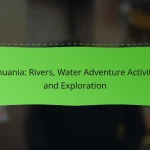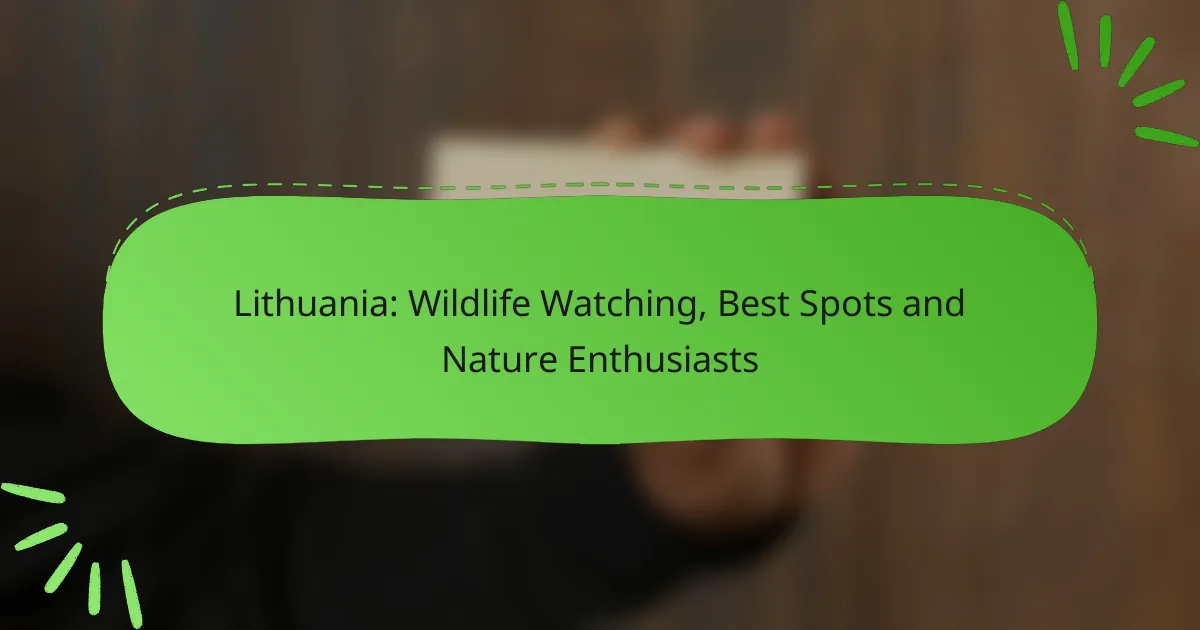Lithuania is a hidden gem for wildlife enthusiasts, boasting a variety of national and regional parks that showcase its rich biodiversity. With diverse habitats ranging from forests to wetlands and coastal areas, visitors can encounter both native and migratory species throughout the year. Each season presents unique opportunities for wildlife watching, making it essential to plan your visits accordingly for the best experience.

Where to watch wildlife in Lithuania?
Lithuania offers diverse habitats for wildlife watching, with several national and regional parks being prime locations. Each park features unique ecosystems and species, making them ideal for nature enthusiasts seeking to observe local fauna in their natural settings.
Curonian Spit National Park
Curonian Spit National Park is a UNESCO World Heritage site known for its stunning sand dunes and rich biodiversity. Visitors can spot various bird species, including the rare black stork, as well as seals along the coast.
To enhance your wildlife watching experience, consider visiting during spring or autumn migration seasons when bird activity peaks. Guided tours are available, providing insights into the unique flora and fauna of the area.
Žemaitija National Park
Žemaitija National Park is characterized by its lush forests, lakes, and wetlands, making it a haven for wildlife. Common sightings include deer, wild boar, and numerous bird species, particularly in the park’s diverse habitats.
For the best experience, explore the park’s numerous hiking trails and lookout points. Early morning or late afternoon are the optimal times for wildlife observation, as animals are more active during these hours.
Trakai National Park
Trakai National Park is famous for its picturesque lakes and historical castles, but it also offers excellent opportunities for wildlife watching. The park is home to various bird species, including swans and herons, as well as mammals like foxes and rabbits.
Visitors can enjoy boat trips on the lakes, which provide a unique vantage point for observing wildlife. Be sure to bring binoculars and a camera to capture the stunning scenery and wildlife encounters.
Nemunas Delta Regional Park
Nemunas Delta Regional Park is a vital wetland area that attracts numerous migratory birds, making it a top spot for birdwatchers. The park’s diverse ecosystems support a wide range of wildlife, including beavers and various fish species.
To maximize your wildlife watching, visit during the migration seasons in spring and autumn. The park offers several observation towers and paths, allowing for easy access to prime viewing locations.
Anykščiai Regional Park
Anykščiai Regional Park features a mix of forests, rivers, and hills, providing a habitat for various wildlife. Commonly spotted animals include deer, wild boar, and a variety of bird species, particularly in the park’s forested areas.
Consider taking part in organized wildlife tours or nature walks to learn more about the local ecosystem. Early mornings are particularly rewarding for spotting active wildlife, so plan your visit accordingly.

What wildlife can be seen in Lithuania?
Lithuania is home to a diverse range of wildlife, including both native and migratory species. Nature enthusiasts can expect to see large mammals, various birds, and unique flora in the country’s forests, wetlands, and coastal areas.
European Bison
The European Bison, or Wisent, is one of the most iconic wildlife species in Lithuania. These majestic animals can be found primarily in the Žemaitija National Park and the Białowieża Forest region, which straddles the border with Poland. Conservation efforts have helped increase their population, making sightings more common.
When observing European Bison, it is best to maintain a safe distance and avoid disturbing their natural habitat. Early morning or late afternoon are the ideal times for spotting these animals, as they are more active during cooler parts of the day.
White-tailed Eagle
The White-tailed Eagle is a prominent bird of prey in Lithuania, known for its impressive wingspan and distinctive white tail. These eagles are often seen near large bodies of water, such as lakes and rivers, where they hunt for fish and waterfowl. The Curonian Lagoon and Nemunas River are prime locations for birdwatching enthusiasts.
To increase your chances of spotting a White-tailed Eagle, consider visiting during the breeding season, which typically runs from late winter to early summer. Binoculars or a telescope can enhance the viewing experience, allowing for closer observation without disturbing the birds.
Common Crane
The Common Crane is a migratory bird that visits Lithuania during the spring and autumn months. These elegant birds are often seen in wetlands and agricultural fields, where they feed on grains and insects. The best time to observe them is during their migration periods, particularly in late March and early October.
For birdwatchers, joining a guided tour can provide valuable insights into crane behavior and habitat. Remember to respect local regulations regarding wildlife observation to ensure the protection of these beautiful creatures.
Red Fox
The Red Fox is a common sight in Lithuania’s forests, fields, and even urban areas. Known for their adaptability, these cunning animals can thrive in various environments. They are primarily nocturnal, making evening walks in nature reserves a good opportunity for spotting them.
When looking for Red Foxes, be quiet and patient. They are naturally curious and may approach if they feel safe. However, it is essential to avoid feeding them, as this can lead to dependency on human food and disrupt their natural foraging behavior.

What are the best seasons for wildlife watching in Lithuania?
The best seasons for wildlife watching in Lithuania are spring, summer, autumn, and winter, each offering unique opportunities to observe different species. Timing your visits according to these seasons can enhance your experience, as various animals are more active or visible during specific times of the year.
Spring migration season
Spring migration season, typically from late March to May, is an exciting time for birdwatchers in Lithuania. Many migratory birds return to the country, including species like storks, cranes, and various songbirds.
During this period, visiting wetlands and coastal areas can yield impressive sightings. Look for organized birdwatching tours or local guides who can help you spot and identify these returning species.
Summer breeding season
Summer, from June to August, is the breeding season for many birds and mammals in Lithuania. This is when you can observe nesting behaviors and young animals learning to survive.
Focus on areas like national parks and nature reserves, where you may see fledglings and other wildlife. Early mornings are particularly good for spotting active animals, so plan your outings accordingly.
Autumn migration season
Autumn migration season runs from September to November, marking another peak time for birdwatching as many species prepare to leave for warmer climates. This is an excellent opportunity to see large flocks of birds, including geese and ducks, gathering in wetlands.
Visit key migration hotspots, such as the Curonian Spit, where you can witness the spectacle of birds taking flight. Bring binoculars to enhance your viewing experience and consider joining local birdwatching events.
Winter wildlife observation
Winter wildlife observation, from December to February, offers a different perspective on Lithuania’s fauna. While many birds have migrated, you can still spot species like owls and various mammals that are active in the snow.
Focus on forested areas and open fields, where tracks in the snow can lead you to wildlife. Dress warmly and be prepared for shorter daylight hours, as this can affect your wildlife watching schedule.

How to prepare for a wildlife watching trip in Lithuania?
Preparing for a wildlife watching trip in Lithuania involves understanding the local ecosystems and selecting the right gear. Researching the best locations and seasons for wildlife sightings will enhance your experience significantly.
Essential gear and equipment
When planning your wildlife watching adventure, essential gear includes binoculars, a camera with a zoom lens, and appropriate clothing for varying weather conditions. Waterproof jackets and sturdy hiking boots are recommended, as many observation spots are in natural reserves or forests.
Consider bringing a field guide to local wildlife, which can help you identify species you encounter. A portable first aid kit and insect repellent are also advisable to ensure a safe and enjoyable experience.
Best practices for wildlife observation
To maximize your wildlife observation experience, maintain a respectful distance from animals to avoid disturbing them. Use binoculars or a camera with a zoom lens for closer views, which allows you to appreciate wildlife without intruding on their habitat.
Early mornings or late afternoons are often the best times for wildlife sightings, as many animals are more active during these hours. Stay quiet and move slowly to increase your chances of spotting animals, and always follow local regulations regarding wildlife interactions to ensure their protection.






